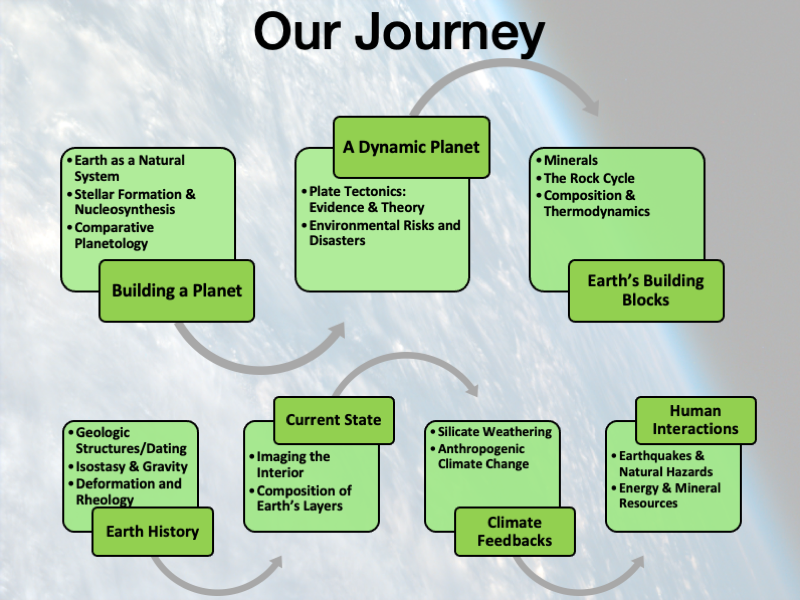Course Syllabus and Readings
Contents
Course Syllabus and Readings#
Welcome to Fundamentals of Solid Earth Science! In the interests of keeping important material somewhere easy to find, this document contains useful information about the course, what will happen when, and our general class policies. If you have any questions or concerns about the information presented here, or about something not covered, please contact Dr. Moulik.

Books#
Several books are used in this course in addition to the primary textbook mentioned below. For topics not sufficiently covered in the primary book, there will be a few readings from other books, which will be provided via Canvas (following Fair Use Provisions of US copyright law).
EPP (primary): Earth, Portrait of a Planet by Stephen Marshak, 7th edition, 2022, Norton Publishers. Hard copies of the text are available at Labyrinth. Used copies, E-textbook, loose-leaf and rental versions are also available via other sellers.
HBHP: How to Build a Habitable Planet by Langmuir and Broecker
IGG: The Solid Earth: An Introduction to Global Geophysics by Fowler (2nd Edition)
NDA: Natural Disasters by Abbott (12th Edition)
ISES: An Introduction to Seismology, Earthquakes & Earth Structure by Stein and Wysession (2nd Edition)
GTS: Geodynamics by Turcotte and Schubert (3rd Edition)
MCO: Minerals: Their Constitution and Origin by Wenk and Bulakh (1st Edition)
MOM: Manual of Mineralogy by Klein and Hurlbut (21st Edition)
TNS: Thermodynamics of Natural Systems by Anderson (2nd Edition)
PTE: Physics of the Earth by Stacey and Davis (4th Edition)
UE: Understanding Earth by Grotzinger and Jordan
TES: The Earth System, by Kump, Kasten and Crane
GE: Geology and the Environment by Pipkin, Trent, Hazlett and Bierman (5th Edition)
WEG: Whole Earth Geophysics: An introductory textbook for geologists and geophysicists by Lillie (1st Edition)
IFL: Isostasy and Flexure of the Lithosphere by Watts (1st Edition)
LITE: Looking into the Earth: An Introduction to Geological Geophysics by Mussett and Khan
DE: Dynamic Earth: Plates, Plumes and Mantle Convection by Davies
MCEP: Mantle convection in the Earth and planets by Schubert, Turcotte and Olson
FOG: Fundamentals of Geophysics by Lowrie (2nd Edition)
CPF: Earth’s Climate-Past and Future by Ruddiman (3rd Edition)
Syllabus#
Part I: Building a planet#
Lecture 1: Earth as a Natural System
Preparation: EPP, Prelude, pp 2-14.
Lecture 2: Stellar Formation and Nucleosynthesis
Preparation:
EPP, Chapter 1, pp 19-41
HBHP, Chapter 3, pp 51-81 e-reserves
Lecture 3: Comparative Planetology
Preparation: EPP, pp 45-51, 612-616, 903
Part II: A Dynamic Planet#
Lecture 4: Plate tectonics: The Evidence
Preparation: EPP, Chapter 3, p 70-93
Lecture 5: Plate tectonics: The Theory
Preparation:
EPP, Chapter 4, pp 94-121
IGG, Chapter 2, pp 5-24 e-reserves
Lecture 6: Phenomenology of Natural Disasters
Preparation:
On earthquakes:
EPP, Chapter 10, Sections 10.1,10.2,10.5, pp 330-341,350-356
NDA, Chapter 4, pp 77-107 e-reserves
On volcanoes: 3. EPP, Chapter 9, Sections 9.1-9.4, pp 288-316 4. NDA, Chapter 6, pp 144-174 e-reserves
Part III: Earth’s Building Blocks#
Lecture 7: Minerals and Introduction to Thermodynamics
Preparation:
EPP, Chapter 5, Sections 5.1-5.5, pp 126-146 : This is a good introduction to minerals, types and settings of formation. Core concepts will be discussed in class and identification exercises will be part of the precept.
TNS, Chapter 2, Sections 2.1-2.3.4, 2.5-2.6.1 pp 11-18, 22-30; Chapter 3, Sections 3.1-3.5.2, pp 38-51: This is a refresher on the basic concepts of thermodynamics that help us understand how material ‘should’ behave when subjected to pressure and temperature. Reality is more complicated but this remains a powerful way to understand what the natural tendency for a system is. e-reserves
Lecture 8: The Rock Cycle I: Introduction to Igneous Rocks
Preparation: EPP, Interlude A.3 (The basis of rock classification), Interlude C and Chapter 6, Section 6.2 (Causes of Melting onwards), pp 157-161, 279-284, 169-193: Core concepts to grasp here are the ways to describe igneous rocks, their formation process and typical tectonic environments.
Lecture 9: The Rock Cycle II: Chemical Composition and Phase Diagrams
Preparation:
TNS, Chapter 6, Sections 6.1-6.3, pp 137-144, Chapter 12.1-12.4.9 (excluding Section 12.2.2 & 12.2.3), pp 293-317: A description of the phase rule, phase diagrams and guidelines to read such plots for whenever you come across them. This should help understand how minerals crystallize out of the molten magma during the formation of igneous rocks. e-reserves
MCO, Chapter 17, pp 288-296 (excluding the section on the ‘Stability of malachite and azurite’): A quick summary of first and second law of thermodynamics, enthalpy, entropy and the concept of Gibbs Free Energy. e-reserves
Lecture 10: The Rock Cycle III: Sedimentary and Metamorphic Rocks
Preparation: EPP, Chapter 7, Section 7.1-7.4, pp 216-242; Chapter 8, Sections 8.1-8.3, 249- 261. Core concepts to grasp here are the ways to describe sedimentary and metamorphic rocks, their formation process and typical tectonic environments.
Part IV: Earth History#
Lecture 11: Geologic Structures and (Relative or Radiometric) Dating
Preparation:
EPP, Chapter 12, Sections 12.1-12.7 (pp 460-491). Introduces the methods of relative (using geologic principles and regional correlations of stratigraphic formations) versus absolute dating (radiometric methods using radiogenic isotopes).
Moorbath 1971, Measuring geological time, Understanding the Earth ed I G Gass, P J Smith and R C L Wilson (Sussex: Artemis). A summary of various radiogenic isotopes and their applications. e-reserves
Lecture 12: Isostasy and Earth’s Topography
Preparation:
EPP, Chapter 11, Section 11.5-11.8, pp 420-437. A broad overview of how mountain ranges form, and relationships between topography and stratigraphic formations.
IFL: Chapter 1, pp 1-20. This is a good historical narration of the concept of isostasy. e-reserves
WEG, Chapter 8, pp 223-243, 260-276 (i.e. excluding the section on ‘Gravity Modeling’). These sections provide the foundation for interpreting gravity maps and understanding isostatic equilibrium in various tectonic settings. e-reserves
Lecture 13,14: Rock Deformation and Rheology
Preparation:
EPP, Chapter 11, Section 11.1-11.4, pp 401-419. Brief description of how brittle deformation regimes in the Earth’s crust manifest as faults, and how plastic deformation regimes manifest as folds. A basic introduction on brittle versus plastic deformation in the Earth and how it relates to stress and strain.
FOG: Chapter 3, Sections 3.1-3.2, pp 121-129. Introduction to elastic theory, which describes the deformation (i.e. strain) when the material subjected to stress (e.g. pressure). e-reserves
FOG: Chapter 2, Section 2.8, pp 105-117. Introduction to viscoelastic theory, which describes time-dependent deformation (i.e. strain rate) when the material subjected to stress (e.g. pressure), exceeding the elastic limit. e-reserves
Part V: Current State of the Earth#
Lecture 15,16: Observational Signatures of Earth’s Evolution
Preparation:
EPP, Interlude D, pp 381-398. A broad overview of geophysical techniques to identify features in the Earth.
ISES, Chapter 5, Sections 5.7 346-366. A focus on the brittle deformation regime. Conditions of brittle fracture along faults and relation to rock properties (e.g. friction) and applied stresses (e.g. confining pressures). e-reserves
DE, Chapter 6, sections 6.1,6.7, 6.8.1, 6.10, pp 124-128,147-152, 166-175. Introduction to various regimes of viscous flow in the mantle resulting in ductile deformation, and strength envelopes that outline the brittle-ductile transition in the upper mantle. e-reserves
Lecture 17: Basic Concepts of Seismology: Tracking Time and Movement
Preparation: FOG, Chapter 3, Sections 3.3-3.6, pp 130-186. Introduction to the various types of seismic waves (body waves, surface waves, normal modes), their propagation through the Earth and what they tell us about earthquakes. e-reserves
Lecture 18: Structure of the Earth I: Bulk Properties and Radial Models
Preparation: FOG, Chapter 3, Sections 3.7, pp 186-202. Summary of properties of the Earth within various regions (crust, mantle, core) as obtained primarily through seismology. e-reserves
Lecture 19: Structure of the Earth II: Lateral Heterogeneity and Seismic Tomography
Preparation: MCEP, Chapter 3, pp 63-116. A good summary of the radial and lateral variations of properties in the Earth’s mantle, the region of the Earth that largely dictates planetary-scale processes like plate tectonics. e-reserves
Part VI: Life and Climate Feedbacks with the Solid Earth#
Lecture 20: Effects of Natural Hazards and Risk Mitigation
Preparation:
On earthquakes:
EPP, Chapter 10, Sections 10.4, 10.6-10.8, pp 347-350, 357-377. A broad overview of how earthquakes cause damage and the possibility of forecasts or predictions.
NDA, Chapter 5, pp 108-143. Case histories of earthquakes in various regions in terms of tectonic setting, hazards and past seismicity. e-reserves
On volcanoes: 3. EPP, Chapter 9, Sections 9.5-9.7, pp 316-325. A broad overview of hazards from volcanoes and their effects on life and climate. 4. NDA, Chapter 7, pp 176-204. Case histories of volcanoes in various regions in terms of tectonic setting, hazards and past eruptions. e-reserves
Lecture 21: Long Term and Anthropogenic Climate Change
Preparation:
EPP, Chapter 23, pp 890-927. Overview of possible changes in the Earth and its climate into the future.
CPF: Chapter 1, Sections 1.4-1.9, pp 8-16. Overview of the climate system, introducing the copes off forcing, response, and feedback. e-reserves
CPF: Chapter 4, pp 82-95, Relates the CO2 emitted from solid Earth phenomenon like volcanoes versus CO2 removed by rock weathering as a thermostat for modulating climate. e-reserves
CPF: Chapter 5, pp 97-118, Relation between Plate Tectonics and Climate. Position of the continents can affect Earth’s radiation balance e.g. during the Snowball Earth events, it is thought the supercontinent being mostly at low latitudes may have made the Earth colder by reflecting more solar radiation than ocean does. e-reserves
Lecture 22: Energy, Resources and Environmental Geoscience
Preparation:
EPP, Chapter 14, pp 535-573. Overview of various natural resources extracted from the solid Earth, and implications for the future.
EPP, Interlude B, pp 197-214. A broad overview of weathering and erosion processes that lead to (various types of) soil formation.

